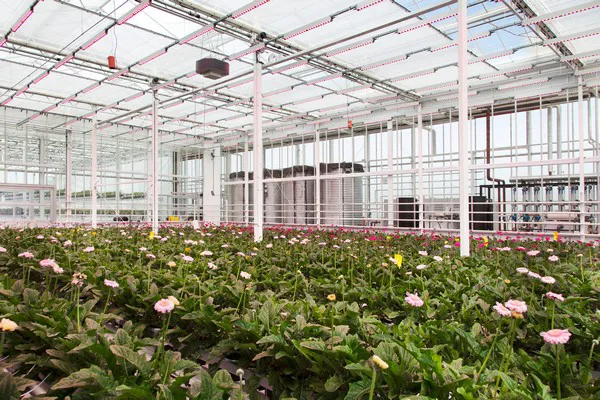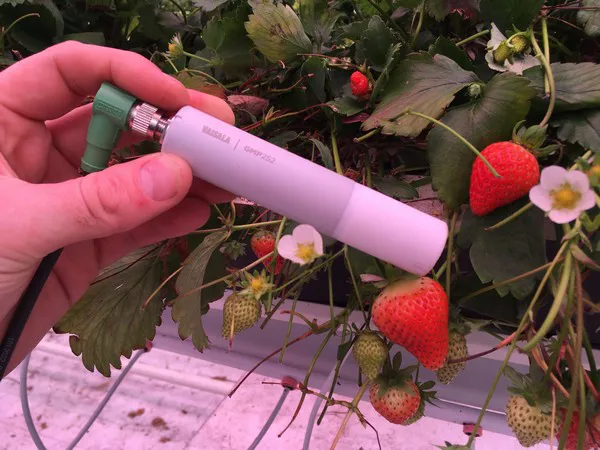Scientists at Wageningen University & Research in the Netherlands have employed Vaisala carbon dioxide sensors in their research greenhouses for over a decade. Carbon dioxide is an extremely important measurement parameter in plant science, not just because plants need carbon dioxide to grow but also because environmental emissions contribute to climate change, so enormous threats and opportunities surround this gas. As a world-renowned research organization, the value of the institute’s work is partly dependent on the accuracy and reliability of sensors, so it is important that its researchers do not compromise on sensor quality.
Wageningen has been one of the driving forces in research and technology development for greenhouse horticulture in the Netherlands. The institute’s expertise in the greenhouse cultivation of ornamental, fruit, and vegetable crops is unique, and together with growers and technology partners, it has developed new cultivation systems, climate control systems, revolutionary greenhouse cover materials, and other innovations. The application of these new technologies has made greenhouse horticulture in the Netherlands a world leader.
The Plant Research Institute operates over 100 greenhouse compartments at its Bleiswijk site, which means that researchers are able to generate a wide variety of environmental conditions. Typical environmental variables include light, water, growing medium, nutrients, (biological) pest/disease control, temperature, humidity, and of course, carbon dioxide (CO2), all of which have significant effects on crop yields.

The Dutch horticultural sector aims to be climate-neutral by 2040. The Wageningen researchers have therefore built a new demonstration greenhouse, ‘Greenhouse 2030,’ for the cultivation of vegetables, fruit, and flowers in an effort to find ways to reduce CO2 emissions as well as eliminating the need for crop protection chemicals and optimize the use of water and nutrients. Pests and diseases are preferably tackled biologically, and the energy-efficient greenhouse reuses water and nutrients as much as possible, leading to cleaner cultivation and improved yields.
Carbon Dioxide in Greenhouses
Carbon dioxide is a byproduct of many processes in the oil, gas, and petrochemical industries, but it is also required by plants to grow through photosynthesis, so Dutch greenhouse operators have collaborated with the country’s industrial sector to utilize this byproduct and thereby contribute in the fight against climate change by lowering the country’s net CO2 emissions. Globally, many greenhouse operators burn natural gas to generate CO2, but this also generates heat that may not be needed in the summer months, so the utilization of an industrial byproduct is significantly preferable.
Carbon dioxide was first delivered to Dutch greenhouses in 2005 via a pipe network established by the company Organic Carbon Dioxide for Assimilation of Plants (OCAP). Commercial greenhouse operators pay for this CO2 supply, which is largely derived from a bioethanol plant. A key feature of the institute’s research is work to optimize the utilization of CO2, along with other plant growth variables. For example, the institute has developed a simulation tool for CO2 dosing: the “CO2-viewer.” This program monitors and displays the effects of a grower’s dosing strategy. For instance, it enables the evaluation of CO2 dosing around midday compared with dosing in the morning. The computational results of such an evaluation take all relevant greenhouse-building characteristics and climate control settings into account.
Monitoring Carbon Dioxide
After around ten years of operation, the institute is replacing around 150 of the older model probes with a newer model. The calibration of all probes is checked prior to the commencement of every project, utilizing certified reference gases. It is important that calibration data is traceable so each probe’s calibration certificate is retained and subsequent calibration checks are documented. A portable CO2 monitor (a Vaisala GM70) with a GMP252 CO2 probe are also used as a validation tool to check installed probes, even though further calibration is not necessary.
Currently, the institute’s installed probes provide 4-20 mA signals which feed into ‘climate computers’ that are programmed to manage the greenhouses automatically. This system also raises alarms if CO2 levels approach dangerous levels for any reason.

CO2 Sensor Technology
Carbon dioxide absorbs light in the infrared (IR) region at a wavelength of 4.26 μm. This means that when IR radiation is passed through a gas containing CO2, part of the radiation is absorbed, and this absorbance can be measured. The Vaisala CARBOCAP® carbon dioxide sensor features an innovative micro-machined, electrically tunable Fabry-Perot Interferometer (FPI) filter. In addition to measuring CO2 absorption, the FPI filter enables a reference measurement at a wavelength where no absorption occurs. When taking the reference measurement, the FPI filter is electrically adjusted to switch the bypass band from the absorption wavelength to a non-absorption wavelength. This reference measurement compensates for any potential changes in the light source intensity, as well as for contamination or dirt accumulation in the optical path. Consequently, the CARBOCAP sensor is highly stable over time, and by incorporating both measurements in one sensor, this compact technology can be incorporated into small probes, modules, and transmitters.
The CARBOCAP technology means that the researchers don’t have to worry about calibration drift or sensor failure.
Carbon Dioxide Plant Science Research
Two projects are currently underway evaluating the effects of different CO2 levels on plant production. One is studying soft fruit and the other tomatoes; however, with CO2 playing such an important role in both plant growth and climate change, the value of accurate measurements of this gas continues to grow. Most of the greenhouses are now connected to the institute’s Ethernet and a wide variety of new sensors are continually being added to the monitoring network, providing an opportunity to utilize new ‘smart’ sensors.
Summary
The accuracy, stability, and reliability of the CO2 sensors at Bleiswijk are clearly vitally important to the success of the institute’s research, particularly because data from one greenhouse are often compared with data from others.
The CO2 supply has a cost; it is, therefore, important that this resource is monitored and supplied effectively so that plant production can be optimized.
Clearly, moves to lower the use of fossil fuels and develop more efficient energy management systems will help to reduce CO2 emissions from the greenhouse sector. However, the importance of CO2 utilization is set to grow, given the 2040 climate-neutral target and the world’s need to find new and better ways to capture CO2 emissions in ways that are both sustainable and economically viable.
For more information:
Vaisala
vaisala.com/en
